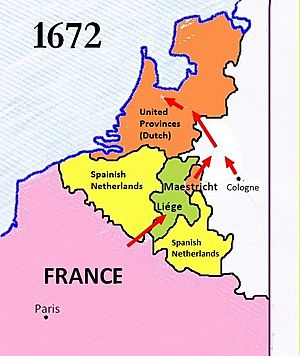Siege of Maastricht (1676) facts for kids
Quick facts for kids Siege of Maastricht (1676) |
|||||||
|---|---|---|---|---|---|---|---|
| Part of the Franco-Dutch War | |||||||
 Siege of Maastricht by the Prince of Orange (William III) in 1676 |
|||||||
|
|||||||
| Belligerents | |||||||
| Commanders and leaders | |||||||
| Strength | |||||||
| 7,000 infantry | 25,000 infantry | ||||||
| Casualties and losses | |||||||
| Unknown | Several thousand | ||||||
The Siege of Maastricht in 1676 was a big battle where William III of Orange tried to take back the city of Maastricht. French forces had controlled Maastricht since 1673. This important event happened during the Franco-Dutch War, from July 6 to August 27, 1676. William III's attempt to recapture the city was not successful.
Contents
Why the War Started: A Quick Look
The Franco-Dutch War was a major conflict in Europe. It began because King Louis XIV of France wanted to expand his kingdom. In an earlier war (1667-1668), France had taken land in the Spanish Netherlands. However, a group called the Triple Alliance (made of the Dutch Republic, England, and Sweden) made France give most of it back.
Louis XIV then worked to break up this alliance. He paid Sweden to stay neutral. England also agreed to join France against the Dutch in a secret deal in 1670.
France's Invasion and Dutch Defenses
France made deals with other areas like Münster and the Electorate of Cologne. This allowed them to go around the defenses in the Spanish Netherlands. In May 1672, they invaded the Dutch Republic. It looked like France would win easily.
But the Dutch army used a clever defense called the Dutch Water Line. They opened gates on June 22, flooding the land. This stopped the French from moving forward. On July 4, William of Orange became the leader, or Stadtholder. He pushed back an invasion from Münster and got back most of the lost land.
By late July, the Dutch were in a stronger position. Other countries worried about France's growing power. Brandenburg-Prussia, Emperor Leopold, and Charles II of Spain started to support the Dutch.

Maastricht's Importance and Changing Alliances
Before railways, goods and supplies moved mostly by water. Rivers like the Meuse were very important for trade and military movements. In June 1673, the French captured Maastricht. This city controlled a key crossing point on the Meuse River.
However, the Dutch took back Naarden in September 1673. Münster and Cologne left the war in November. Then, in early 1674, Denmark joined the alliance against France. England also made peace with the Dutch in the Treaty of Westminster. France was now fighting too many enemies. They pulled their troops out of the Dutch Republic, but they kept control of Maastricht.
The Siege of Maastricht Begins
In the summer of 1676, William III decided it was time to remove the French from Maastricht. He had the support of Carlos de Gurrea, who was the Governor of the Habsburg Netherlands. On July 3, William gathered his forces near Nivelles. They began their march towards Maastricht.
The combined armies reached Maastricht on July 6. William was in charge, with General Georg Friedrich of Waldeck helping him. The Spanish forces were led by de Gurrea. Soldiers from England, Brandenburg, and Palatinate-Neuburg also joined the attack.
Attacks and Challenges During the Siege
Because of some delays, the first big attack on the city did not happen until July 21. The main focus was on the Zyl Fronts, which was a part of the city's defenses in the northwest. This area was thought to be the weakest point.
During the attacks in late July and August, the Dutch forces lost many soldiers. About a thousand were injured or killed. In early August, Karel Florentine of Salm, a top general and William III's close helper, was badly hurt and died.
While the fighting continued, peace talks were happening in Nijmegen. These talks did not stop the siege at the time. However, they later led to important peace agreements known as the Treaties of Nijmegen.
The Siege Ends: French Relief Arrives
On August 17, William received an important letter. It was meant for the French commander inside Maastricht but was intercepted. The letter said that a French relief army was on its way to break the siege. William met with Waldeck and other military leaders to discuss this news.
The siege continued, and the Dutch forces tried to get around the French defenses through the suburb of Wyck on August 23. But with the French relief army getting closer, the siege was finally given up on August 27.
There were different ideas about why the siege failed. Some people thought the Dutch commanders were not strong enough. Others believed William's allies did not give enough support. Another idea was that the low water level of the Meuse river meant the Dutch army did not have enough water supplies.

